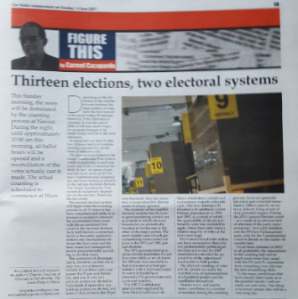Malta’s electoral system has, over the years, been transformed into a duopoly. Discrimination is inbuilt into electoral legislation in order to effectively ensure that Parliament remains a two-party affair. It is discrimination by design. It is not accidental but specifically intended.
Our electoral system (STV: Single Transferable Vote) started off being applied in 1921 as one focused on the individual candidate, generally ignoring the political parties. Over the years a number of important changes shifted the focus of the STV from the individual candidate to the political party.
The first such change was carried out prior to the 1976 general elections: the electoral ballot paper was then redesigned such that same party candidates started being grouped together with a colour code identifying the different political parties. This was a radical change as up to that point, for over fifty years, all candidates in an electoral district were listed alphabetically. Up till that point it was a common occurrence for votes to switch from one party to the other in successive counts as the semi-literate voter, would not always distinguish between one party candidate and the candidates from other parties. As a result, many a parliamentary seat was lost or switched allegiance over the years.
The second change took place in 1987 and was fine-tuned in subsequent years. It started off as a reaction to the impact of jerrymandering of electoral districts, specifically the 1981 general election result. Originally it was designed as a constitutional guarantee for majority rule, ensuring that whichever political party surpassed the 50 per cent vote count it would be guaranteed a majority of parliamentary seats. Subsequently it was developed into a formula for ensuring proportionality between first count votes and parliamentary seats. There is however an important condition attached: this is only applicable if just two political parties make it to parliament. The moment that a third one gains just one seat, no proportionality is guaranteed, except in one specific instant: when a political party obtains in excess of the 50 per cent mark it is still guaranteed a majority of Parliamentary seats. Our Constitution expects that the rest have to lump it.
The third change is in the pipeline. It involves an additional adjustment: a gender balance mechanism. A maximum of twelve parliamentary seats will be added to the total to represent the under-represented gender! Yes, you have guessed: they will be split equally between the duopoly. In addition, the seats will not be available for distribution the moment a third political party makes it into parliament.
Let me be very clear. Proportionality between votes cast and parliamentary seats won is essential. Likewise, it is essential to address the gender imbalance in our parliament. However, both adjustments can be done fairly, without any discrimination, and importantly without increasing the size of Parliament astronomically as will inevitably happen at the next general election if only two political parties make it to Parliament. In fact, it is perfectly possible not to have any increase in size of Parliament at all if the appropriate changes are carried out!
Over the years the political party which I lead has made several proposals on these matters. The latest proposal was made in the context of the public consultation on addressing gender imbalance in Parliament. Even then we emphasised that tinkering with the electoral system and adding top-ups would not solve anything. A complete overhaul of the system is required. Instead, the “gender balance reform” ended up advocating “as little as possible disruption of the electoral system”. Government and Opposition agreed to reinforce the existing discrimination in our electoral system.
Unfortunately, our proposals have been ignored once more and we have no choice but to resort to our Courts to address a blatantly discriminatory electoral system imposed on us by Labour and Nationalist Members of Parliament. On such matters they always agree.
In such circumstances fragmentation of the political spectrum is the worst possible option for those who want to emphasise a specific point. Those who end up playing the “independent” are pawns of the duopoly, unwittingly reinforcing the two-party system. They end up siphoning votes and thereby deliberately weakening a potential third voice which can make it to Parliament. The merger between AD and PD in the past months is the appropriate antidote in such circumstances.
Instead of focusing on minor differences it would be appropriate if all of us give more weight to the overall picture. It is an uphill struggle, but we should not be deterred!
published on The Malta Independent on Sunday 30 May 2021

